Cressida |
||||||||||||||||||||||||||||||||||||||||||||||
 |
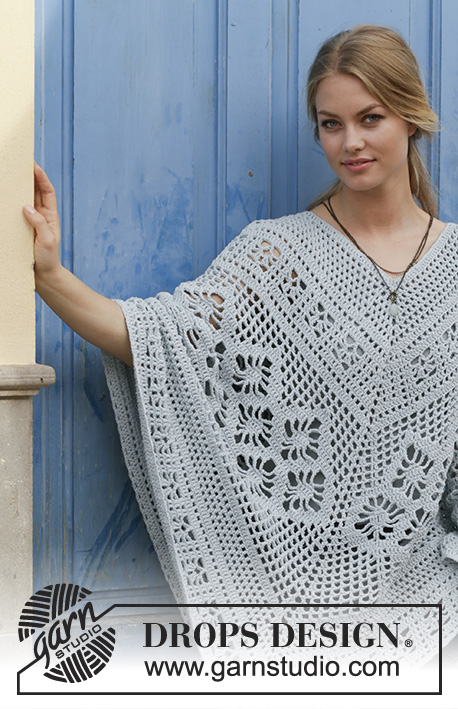 |
|||||||||||||||||||||||||||||||||||||||||||||
Crocheted poncho with lace pattern, worked top down. Size: S - XXXL Piece is crocheted in DROPS Paris.
DROPS 188-27 |
||||||||||||||||||||||||||||||||||||||||||||||
|
INFORMATION FOR PATTERN: PATTERN: See diagrams A.1 to A.5. CROCHET INFO: The first treble crochet at the beginning of round are replaced with 3 chain stitches. Finish round with 1 slip stitch in 3rd chain stitch at beginning of round, then work slip stitches until middle space. DECREASE TIP - WORK 2 DOUBLE TREBLE CROCHETS TOGETHER: Work 1 double treble crochet around chain space below but wait with last pull through (= 2 stitches on hook), skip 1 double crochet and work 1 double treble crochet around next chain space but on last pull through pull yarn through all loops on hook. INCREASE TIP: Increase 1 treble crochet by working 2 treble crochets in same stitch. ---------------------------------------------------------- PONCHO: Poncho is worked in the round, top down. First increase mid front, mid back and on each side of each shoulder, then increase only mid front and mid back. Work 156-166-166 chain stitches on hook size 4.5 mm with Paris and form a ring with 1 slip stitch in first chain stitch. Work 3 chain stitches - read CROCHET INFO! Then work 1 treble crochet in each of the next 5-3-3 chain stitches, * skip 1 chain stitch, work 1 treble crochet in each of the next 5 chain stitches *, work from *-* 25-27-27 times in total = 130-138-138 treble crochets + 3 chain stitches at beginning of round. REMEMBER THE CROCHET TENSION! Now insert 6 markers from beginning of round as follows (without working): Insert 1 marker in 1st treble crochet on round (i.e. in treble crochet after the 3 chain stitches = mid back), skip 24-26-26 treble crochets, insert 1 marker in next treble crochet (= shoulder), skip 14 treble crochets, insert 1 marker in next treble crochet (= shoulder), skip 24-26-26 treble crochets, insert 1 marker in next treble crochet (= mid front), skip 24-26-26 treble crochets, insert 1 marker in next treble crochet (= shoulder), skip 14 treble crochets, insert 1 marker in next treble crochet (= shoulder), there are now 24-26-26 treble crochets between last marker and beginning of round. WORK A.1 AS FOLLOWS: Work 1st round as follows: Work * A.1A in first/next treble crochet with marker (= mid front/mid back), repeat A.1C 12-13-13 times in total, A.1D in next treble crochet with marker (= shoulder increase), repeat A.1E 7 times in total, A.1D in next treble crochet with marker (= shoulder increase), A.1E 12-13-13 times in total *, work from *-* 2 times in total. Work 2nd round as follows: Work * A.1A (= mid front/mid back), A.1B, repeat A.1C 12-13-13 times in total, A.1D (= shoulder increase), repeat A.1E 7 times in total, A.1D (= shoulder increase), A.1E 12-13-13 times in total, A.1F *, work from *-* 2 times in total. Continue to and with 6th-7th-8th round in diagram A.1. There are now 108-128-132 stitches between chain space mid front and mid back (= 216-256-264 stitches + 2 middle spaces on round). Piece measures approx. 8-9-10 cm in crochet direction (measure down from the shoulder from the cast-on edge). ROUND WITH TREBLE CROCHETS: Work 1 round with treble crochets, work (2 treble crochets, 3 chain stitches, 2 treble crochets) around middle space, and adjust AT THE SAME TIME number of treble crochets to decrease/increase as follows: S/M – XXL/XXXL: Increase 1-1 treble crochet along each of the sides between mid front/mid back (= 2-2 treble crochets in total) – read INCREASE TIP L/XL: Decrease 7 treble crochets along each of the sides between mid front/mid back (= 14 treble crochets in total) – read DECREASE TIP There are now 113-125-137 stitches between chain space mid front and mid back (= 226-250-274 stitches + 2 middle spaces on round). NOTE! Do not increase on each side of each shoulder onwards, but only mid front and mid back on poncho! WORK A.2/A.3 AS FOLLOWS: Work * A.3A (= middle space), A.3B over 3 treble crochets, A.2 (= 12 stitches) 9-10-11 times in total in width, A.3C over the next 2 treble crochets *, work from *-* 2 times in total. On 9th round increase 12-24-36 treble crochets evenly on each side of A.3A (i.e. increase 24-48-72 treble crochets in total on round) = 145-169-193 treble crochets between chain space mid front and mid back (= 290-338-386 treble crochets in total + 2 middle spaces on round) – read INCREASE TIP. Piece measures approx. 19-20-21 cm in crochet direction from cast-on edge. WORK A.4/A.5 AS FOLLOWS: Work * A.5A (= middle space), A.5B, A.4 (= 24 stitches) 6-7-8 times in total in width, A.5C over next treble crochet *, work from *-* 2 times in total. When A.5 has been done vertically, 19 rounds have been worked, continue on 20th round as follows: Work * A.5D, A.5E over 1 treble crochet, A.5F 7 times in total in width, A.4 (= 24 stitches) 6-7-8 times in total in width, A.5F 7 times in total in width, A.5G *, work from *-* 2 times in total. When A.4/A.5 have been worked, there are 211-235-259 treble crochets between chain space mid front and mid back (= 422-470-518 treble crochets in total + 2 middle spaces on round). Piece measures approx. 46-47-48 cm in crochet direction from cast-on edge. WORK 2ND AND 3RD ROUND IN A.1 AS FOLLOWS: Begin around one middle space and begin from 3rd round in diagram. Work * A.1A (= middle space), repeat A.1C until next middle space (work last stitch only over 1 stitch on first round *, work from *-* 2 times in total. Repeat 2nd and 3rd round until 4-8-10 rounds have been worked in total. Piece measures approx. 51-56-59 cm in crochet direction from cast-on edge. ROUND WITH TREBLE CROCHETS: Work 1 round with treble crochets and decrease AT THE SAME TIME 7-5-5 treble crochets evenly along each of the sides between mid front/mid back (= 14-10-10 treble crochets in total) as follows: Work * (2 treble crochets, 3 chain stitches, 2 treble crochets) around middle space, then work 1 treble crochet in every treble crochet and 1 treble crochet around every chain stitch until next middle space *, work from *-* 2 times in total = 209-245-269 treble crochets between chain space mid front and mid back (= 418-490-538 treble crochets + 2 middle space on round). Cut the yarn. WORK A.2/A.3 AS FOLLOWS: Work * A.3A (= middle space), A.3B over 3 treble crochets, A.2 (= 12 stitches) 17-20-22 times in total in width, A.3C over the next 2 treble crochets *, work from *-* 2 times in total. When A.2/A.3 have been worked, there are 229-265-289 treble crochets between chain space mid front and mid back (= 458-530-578 treble crochets + 2 middle spaces on round). Piece measures approx. 62-67-70 cm in crochet direction from cast-on edge. EDGE: Work a finishing edge around the entire poncho as follows: 1 slip stitch in first stitch, * work 3 chain stitches, skip 2 stitches, 1 double crochet in next stitch *, work from *-* the entire round and finish with 1 slip stitch in slip stitch at beginning of round. Fasten off. |
||||||||||||||||||||||||||||||||||||||||||||||
Diagram explanations |
||||||||||||||||||||||||||||||||||||||||||||||
|
||||||||||||||||||||||||||||||||||||||||||||||
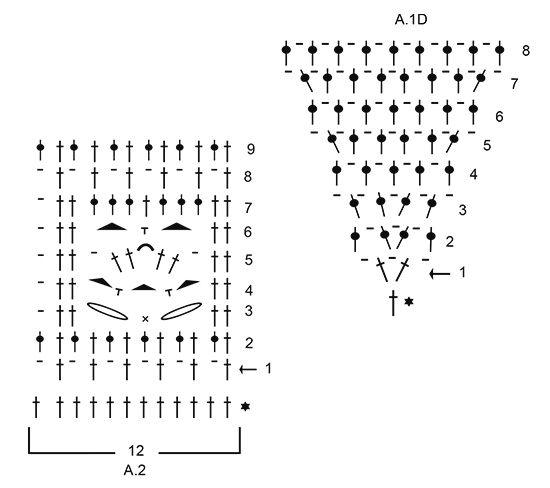
|
||||||||||||||||||||||||||||||||||||||||||||||
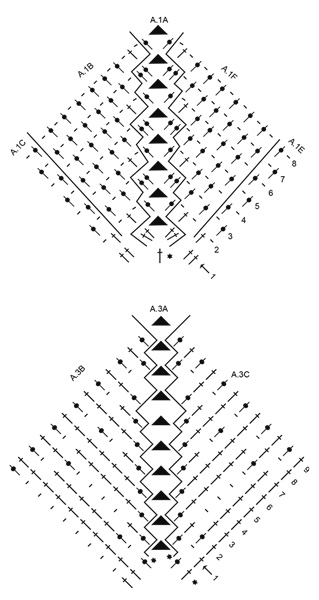
|
||||||||||||||||||||||||||||||||||||||||||||||

|
||||||||||||||||||||||||||||||||||||||||||||||
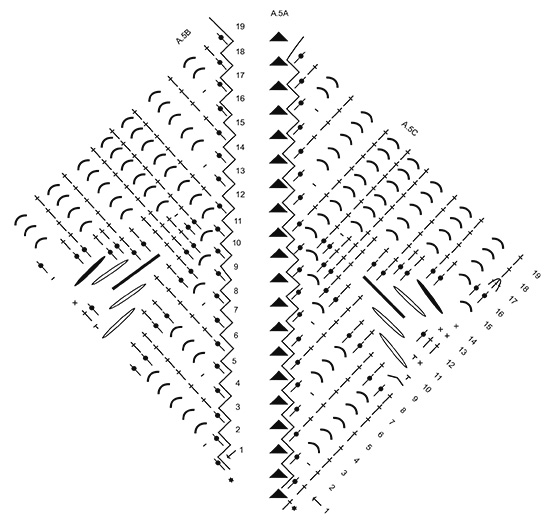
|
||||||||||||||||||||||||||||||||||||||||||||||

|
||||||||||||||||||||||||||||||||||||||||||||||
|
Have you made this or any other of our designs? Tag your pictures in social media with #dropsdesign so we can see them! Do you need help with this pattern?You'll find tutorial videos, a Comments/Questions area and more by visiting the pattern on garnstudio.com. © 1982-2024 DROPS Design A/S. We reserve all rights. This document, including all its sub-sections, has copyrights. Read more about what you can do with our patterns at the bottom of each pattern on our site. |
||||||||||||||||||||||||||||||||||||||||||||||
































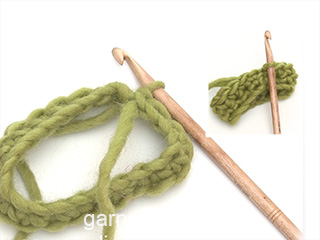
























Comments / Questions (66)
Bonjour au 3eme rang il faut répéter A1B, donc 1 ml, 1 b, 1ml ( ce qui fait un enchaînement de 2ml) ou dois je faire 1ml, 1 b, 1ml, 1 b.... en répétition. Car cela fais plusieurs fois que je recommence et je ne tombe jamais juste sur le compte de maille à la fin soit 108m. Cordialement.
24.12.2019 - 12:22DROPS Design answered:
Bonjour Gaetane, au 3ème rang de A.1B vous crochetez: 1 ml, 1 bride dans la bride suivante, 1 ml, 1 bride autour de l'arceau suivant, 1 ml, 1 bride autour de l'arceau suivant, 1 ml, 1 bride autour de l'arceau suivant, puis vous crochetez A.1c = 1 ml, 1 bride autour de l'arceau suivant. Bon crochet!
02.01.2020 - 10:47Suite du message précédent... Il y a t-il bien, dans le tour de brides, un arceau devant et dos comme suit : 2 brides, 3 mailles en l'air, 2 brides ? Cordialement
15.12.2019 - 22:40DROPS Design answered:
Bonjour Gaetane, A.3 = 3 mailles en l'air (=3ème symbole). commencez le tour par 3 ml (= pour remplacer la 1ère bride) et terminez le tour par 1 mc dans la 3ème ml du début du tour (= vous pouvez soit considérer que ces 3 m sont la dernière bride de A.3C ou bien faire ces 3 ml en plus de la dernière bride de A.3C). Bon crochet!
16.12.2019 - 09:04Bonjour, pourriez vous me donner de plus amples explications sur le 1er rang de A3 après le tour de brides. Dois je faire brides, maille en l'air, bride dans l'arceau ou n'y a t-il que 3 mailles en l'air au dessus de l'arceau du rang précédent. Je ne comprend pas car le diagramme A3a ne représente que 3 mailles en l'air et je ne voit pas où il faut commencer les brides. Merci de votre attention à mon message. Cordialement
15.12.2019 - 22:24DROPS Design answered:
Bonjour Gaétane, les diagrammes A.3 se crochètent comme le montre les diagrammes, par ex. au 1er rang: A.3C = 1 b dans la b, 1 ml, sautez 1 b, 1 b dans l'arceau - A.3A = 3 ml - A.3C = 1 b dans l'arceau, 1 ml, sautez 1 b, 1 b dans la b suivante, 1 ml, sautez 1 b. Suivez bien le diagramme, vous allez ensuite crocheter des brides soient dans la bride du tour précédent, soit autour de l'arceau. Bon crochet!
16.12.2019 - 09:02In the beginning of the pattern when placing stitch markers, in the American english version...is there an error in regards to the instructions. The stitch count does not add or line up, so I am confused. I have read the instructions several times and tried doing the stitch markers and I am still sending with a huge number of stitches before the first marker. Is there a section missing?
21.11.2019 - 23:35DROPS Design answered:
Dear Mrs Blevins, at the end of first round you should have 130-138-138 dc + 3 ch, you then insert markers as follows: marker in first dc, 24-26-26 dc, marker in next st, 14 dc, marker in next st, 24-26-26 dc, marker in next st, 24-26-26 dc, marker in next st, 14 dc, marker in next st, 24-26-26 dc = 1 + (24-26-26) + 1 + 14 + 1 + (24-26-26 ) +1+ (24-26-26) +1+14+1+ (24-26-26)=130-138-138 sts. Happy crocheting!
22.11.2019 - 08:20Hej Nu er jeg gået i gang med denne poncho men jeg kan altså ikke forstå det der står med A.1 og alt det kan jeg både om en dybere forklaring :) Mvh Camilla
29.07.2019 - 15:25Also there is no A2 diagram.
15.07.2019 - 23:35DROPS Design answered:
Hi Sarah, All the diagrams are at the bottom of the page, Happy crocheting!
16.07.2019 - 06:59On instructions for round 2, towards the end it states continue to and with 6th-7th-8th round in diagram A.1. but there isn't just an A.1. which diagram am I looking at exactly please
15.07.2019 - 23:21DROPS Design answered:
Dear Sarah, all diagrams A.1 have the same number of rows, just work to the 6th-7th-8th round included in A.1. Happy crocheting!
16.07.2019 - 09:34Bonjour, Je suis arrivée au tour 9. Dois je faire un tour de brides uniquement en ajoutant 72 augmentations ou dois je suivre le diagramme A3? Merci de votre réponse. Bien cordialement.
06.12.2018 - 11:33DROPS Design answered:
Bonjour Mme Parmentier, vous crochetez le 9ème tour en suivant les diagrammes comme avant = le tour 9 dans A.3 et A.2 est un tour en brides, en même temps, vous augmentez 36 brides de chaque côté de A.3A (= soit 72 brides au total). Bon crochet!
06.12.2018 - 12:45Kez wrote:
Hi there, I love this pattern but am really stuck after placing the stitch markers. I’m having issues following the diagram, I’m not sure how you start, completely confused. I understand the stitches and can follow the video tutorials no problem but just don’t get the diagram. Please help me cos I really want to make it, it’s so beautiful
01.12.2018 - 04:13DROPS Design answered:
Dear Kez, work the diagram starting from the row with the arrow and read every round from the right towards the left. Each symbol represents one stitch/group of stitches as explained under diagram key. Happy crocheting!
03.12.2018 - 08:31Ich versteh leider die Häkelinfo nicht. KM in die 3. LM ist klar, aber was heißt KM bis zur Mitte des Luftmaschenbogens?
01.11.2018 - 22:32DROPS Design answered:
Liebe Nina, damit die Runde an der richtigen Stelle beginnt, häkelt man 1 KM in jede Lm bis zur Mitte des Luftmaschenbogens, dann beginnt die nächste Rund mit 3 Lm (= 1. Stb). Viel Spaß beim häkeln!
02.11.2018 - 07:56